
Allocasuarina huegeliana, commonly known as rock sheoak is a species of flowering plant in the family Casuarinaceae and is endemic to Western Australia. It is a dioecious tree that has its leaves reduced to scales in whorls of eight to ten, the mature fruiting cones 14–35 mm (0.55–1.38 in) long containing winged seeds (samaras) 5–7 mm (0.20–0.28 in) long.

Allocasuarina lehmanniana, commonly known as dune sheoak, is a species of flowering plant in the family Casuarinaceae and is endemic to near-coastal areas of the south-west of Western Australia. It is dioecious or less commonly a monoecious shrub that has its leaves reduced to scales in whorls of six to eight, the mature fruiting cones 12–35 mm (0.47–1.38 in) long containing winged seeds (samaras) 4.0–5.5 mm (0.16–0.22 in) long.
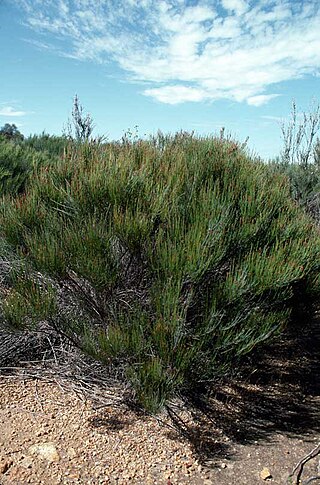
Allocasuarina campestris is a species of flowering plant in the family Casuarinaceae and is endemic to the south-west of Western Australia. It is a dense, monoecious or dioecious shrub that has more or less erect branchlets, the leaves reduced to scales in whorls of seven to nine, the mature fruiting cones 19–42 mm (0.75–1.65 in) long containing winged seeds (samaras) 4.7–10 mm (0.19–0.39 in) long.

Allocasuarina simulans, commonly known as Nabiac casuarina, is a species of flowering plant in the family Casuarinaceae and is endemic to a restricted part of eastern New South Wales. It is a usually a dioecious shrub with branchlets up to 190 mm (7 in) long, the leaves reduced to scales in whorls of six, the fruiting cones 14–33 mm (0.6–1 in) long containing winged seeds (samaras) 4.5–6.0 mm (0.18–0.24 in) long.

Allocasuarina defungens, commonly known as dwarf heath casuarina, is a species of flowering plant in the family Casuarinaceae and is endemic to a restricted area of New South Wales. It is a straggly, dioecious or monoecious shrub that has branchlets up to 120 mm (4.7 in) long, the leaves reduced to scales in whorls of five to seven, the fruiting cones 8–11 mm (0.31–0.43 in) long containing winged seeds (samaras) about 3 mm (0.12 in) long.
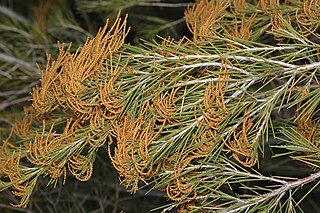
Allocasuarina acuaria is a species of flowering plant in the family Casuarinaceae and is endemic to the southwest of Western Australia. It is a dioecious shrub that has erect branchlets, the leaves reduced to scales in whorls of four on the ends of the branchlets, the fruiting cones 15–19 mm (0.59–0.75 in) long containing winged seeds (samaras) about 6 mm (0.24 in) long.

Allocasuarina acutivalvis is a species of flowering plant in the family Casuarinaceae and is endemic to the southwest of Western Australia. It is a dioecious shrub to small tree that has erect branchlets, the leaves reduced to scales in whorls of 10 to 14, the fruiting cones 15–35 mm (0.59–1.38 in) long containing winged seeds (samaras) 6–12 mm (0.24–0.47 in) long.
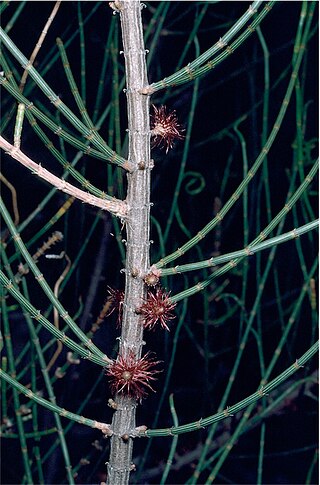
Allocasuarina corniculata is a species of flowering plant in the family Casuarinaceae and is endemic to the south-west of Western Australia. It is an erect to spreading, dioecious shrub that has more or less erect branchlets, the leaves reduced to scales in whorls of six to eleven, the mature fruiting cones 8–15 mm (0.31–0.59 in) long containing winged seeds (samaras) 3–4 mm (0.12–0.16 in) long.

Allocasuarina dielsiana, commonly known as northern sheoak, is a species of flowering plant in the family Casuarinaceae and is endemic to the south-west of Western Australia. It is a dioecious tree that has more or less erect branchlets, the leaves reduced to scales in whorls of six to eight, and the mature fruiting cones 14–30 mm (0.55–1.18 in) long containing winged seeds (samaras) 8–10 mm (0.31–0.39 in) long.
Allocasuarina globosa is a species of flowering plant in the family Casuarinaceae and is endemic to a restricted part of inland Western Australia. It is a dioecious shrub that has more or less erect branchlets, its leaves reduced to scales in whorls of ten to twelve, the mature fruiting cones more or less spherical and 15–17 mm (0.59–0.67 in) long, containing winged seeds (samaras) 6.0–6.5 mm (0.24–0.26 in) long.

Allocasuarina grevilleoides is a species of flowering plant in the family Casuarinaceae and is endemic to the south-west of Western Australia. It is a small, spreading, dioecious shrub that forms a lignotuber, and has more or less erect, sharply-pointed branchlets, the leaves reduced to scales in whorls of four, the mature fruiting cones 9–14 mm (0.35–0.55 in) long containing winged seeds (samaras) 5.5–7.0 mm (0.22–0.28 in) long.
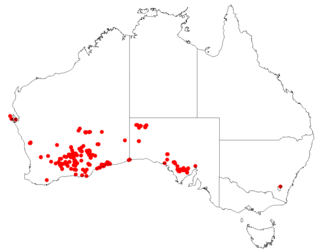
Allocasuarina helmsii is a species of flowering plant in the family Casuarinaceae and is endemic to the south-western Australia. It is a dioecious shrub that erect branchlets, the leaves reduced to scales in whorls of five or six, and mature fruiting cones 15–33 mm (0.59–1.30 in) long containing winged seeds (samaras) 4–5 mm (0.16–0.20 in) long.

Allocasuarina scleroclada is a species of flowering plant in the family Casuarinaceae and is endemic to areas along the south coast of Western Australia. It is a straggly, dioecious shrub that has branchlets up to 230 mm (9.1 in) long, the leaves reduced to scales in whorls of ten or eleven, the mature fruiting cones 18–25 mm (0.71–0.98 in) long containing winged seeds 5–8 mm (0.20–0.31 in) long.

Allocasuarina spinosissima is a species of flowering plant in the family Casuarinaceae and is endemic to Western Australia. It is a monoecious shrub with its leaves reduced to overlapping scales in whorls of nine to eleven, the mature fruiting cones 10–23 mm (0.39–0.91 in) long, containing winged seeds 5.5–7.0 mm (0.22–0.28 in) long.

Allocasuarina thuyoides, commonly known as horned sheoak, is a species of flowering plant in the family Casuarinaceae and is endemic to the south-west of Western Australia. It is monoecious or dioecious shrub that has its leaves reduced to scales in whorls of five or six, the mature fruiting cones 8–20 mm (0.31–0.79 in) long containing winged seeds usually 5.0–6.0 mm (0.20–0.24 in) long.
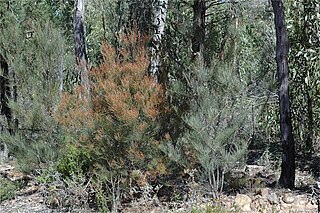
Allocasuarina diminuta is a species of flowering plant in the family Casuarinaceae and is endemic to eastern New South Wales. It is a dioecious or monoecious shrub or small tree that has branchlets up to 230 mm (9.1 in) long, the leaves reduced to scales in whorls of six to ten, the fruiting cones 5–20 mm (0.20–0.79 in) long containing winged seeds (samaras) 3.5–5.0 mm (0.14–0.20 in) long.

Allocasuarina mackliniana is a species of flowering plant in the family Casuarinaceae and is endemic to southern continental Australia. It is a dioecious, rarely a monoecious shrub that has more or less erect branchlets up to 200 mm (7.9 in) long, the leaves reduced to scales in whorls of seven to ten, the fruiting cones 12–22 mm (0.47–0.87 in) long containing winged seeds (samaras) 5–8 mm (0.20–0.31 in) long.

Allocasuarina muelleriana, commonly known as slaty sheoak, is a species of flowering plant in the family Casuarinaceae and is endemic to southern continental Australia. It is a dioecious, rarely a monoecious shrub that has branchlets up to 120 mm (4.7 in) long, the leaves reduced to scales in whorls of five to eight, the fruiting cones 14–30 mm (0.55–1.18 in) long containing winged seeds 6–9 mm (0.24–0.35 in) long.
Allocasuarina filidens, commonly known as the Mt Beerwah she-oak, is a species of flowering plant in the family Casuarinaceae and is endemic to a restricted area of Queensland. It is a dioecious shrub that has more or less erect branchlets up to 200 mm (7.9 in) long, the leaves reduced to scales in whorls of five or six, the fruiting cones 14–30 mm (0.55–1.18 in) long containing winged seeds (samaras) 6.5–9 mm (0.26–0.35 in) long.

Allocasuarina rigida is a species of flowering plant in the family Casuarinaceae and is endemic to eastern Australia. It is a dioecious shrub that has branchlets up to 330 mm (13 in) long, the leaves reduced to scales in whorls of seven to ten, and the fruiting cones 8–27 mm (0.31–1.06 in) long containing winged seeds 3.0–7.5 mm (0.12–0.30 in) long.



















